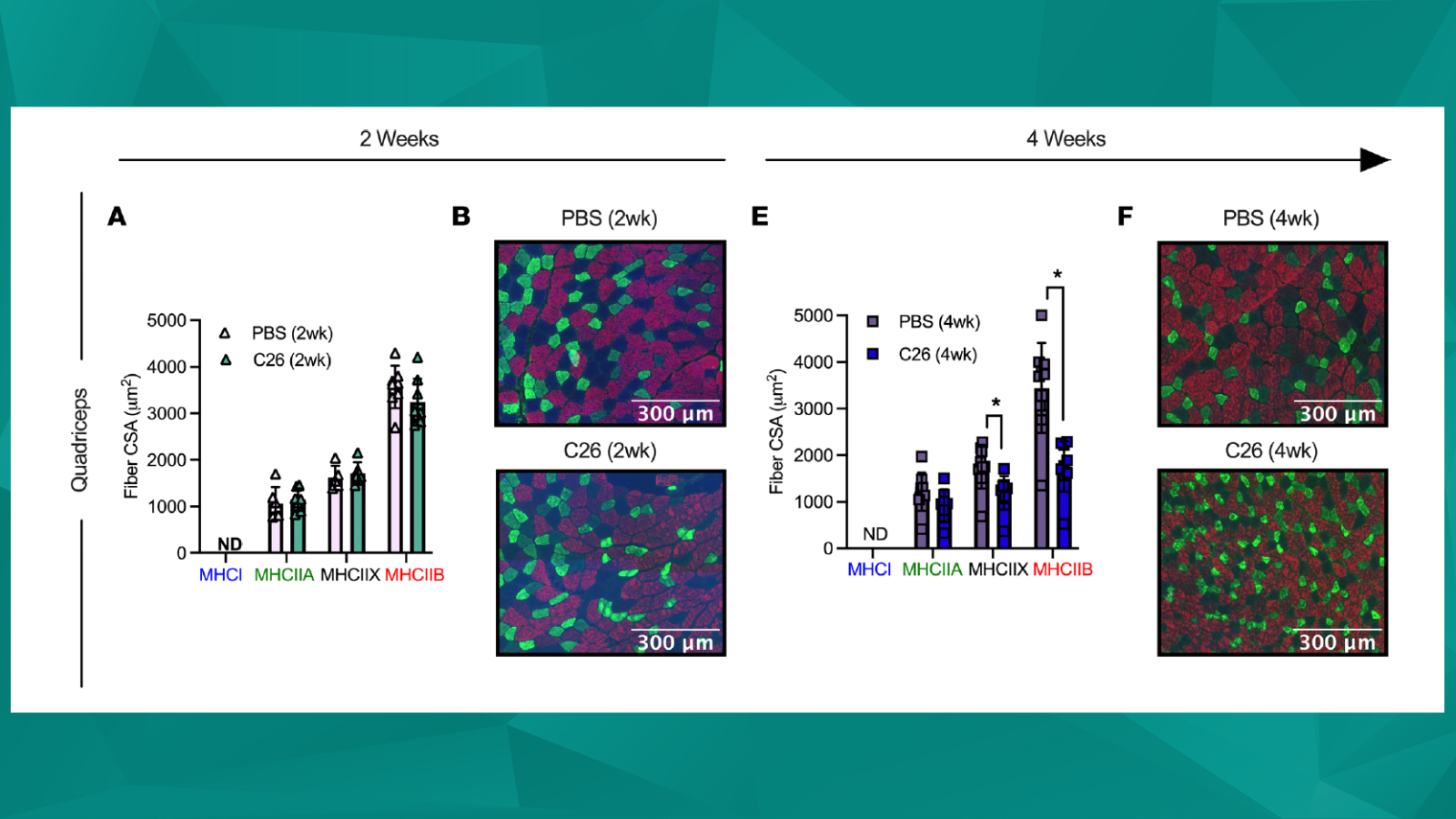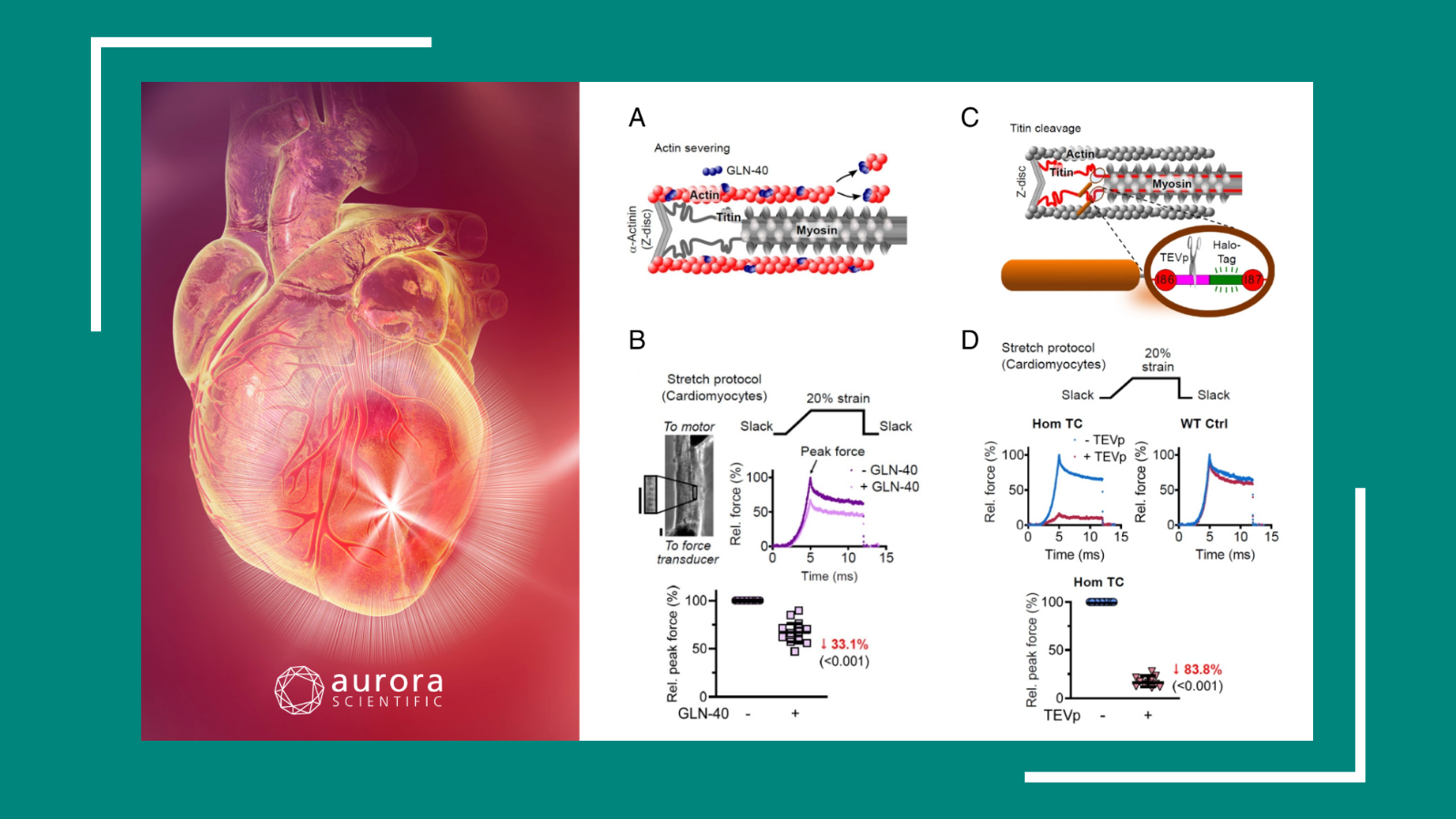
Cancer cachexia is a muscle wasting syndrome that is associated with certain cancers, but most commonly with advanced malignancies. This syndrome arises as a result of tumor-induced metabolic changes, causing the body to break down skeletal muscle and adipose tissue in response to nutritional deficiencies. These changes manifest as severe weight loss, anorexia, asthenia, and anemia, impairing the patient’s capacity to tolerate infections, chemotherapy, and radiation treatments (Dhanapal et al., 2022). While research characterizing the multifactorial origins of this syndrome is still ongoing, three recent publications featuring our scientific equipment have made notable advances in the current understanding of this muscle wasting disease, and are discussed in this publication review.
Featured image (©Delfinis et al. (2022), licensed under CC BY 4.0), illustrates evaluation of quadriceps fiber type atrophy in skeletal muscle from C26 mice at 2 weeks and 4 weeks of tumor–bearing.
Muscle weakness precedes atrophy during cancer cachexia and is linked to muscle-specific mitochondrial stress
In a 2022 article, Delfinis et al. delineate elements of the muscle wasting process, specifically investigating which of muscle weakness or atrophy occur first in cancer cachexia patients. In brief, mice were inoculated with Colon-26 cancer cells, and our 1300A 3-in-1 Whole Animal System for Mice was used to measure in situ quadricep and in vitro diaphragm force production, revealing a decrease in specific muscle force prior to atrophy in both muscles. Notably, quadricep force production returned to control levels by four weeks, indicating a likely intrinsic compensation as absolute force was lower at this later time point. Additionally, muscle atrophy was preceded by altered mitochondrial bioenergetics, with differing effects on cellular respiration in the two muscles studied. These heterogeneous, muscle-specific, and time-dependent mitochondrial responses are likely a result of unique impairment in the coupling of the mtCK system to ATP generation in quadriceps, caused by this specific colon cancer. These findings demonstrate how cancer cachexia can have differing effects on specific muscles, highlighting the importance of understanding the heterogeneous response of muscle tissues to this syndrome (Delfinis et al., 2022).
Blocking muscle wasting via deletion of the musclespecific E3 ligase MuRF1 impedes pancreatic tumor growth
In addition to colon cancer, pancreatic cancer also causes cancer-induced muscle wasting. One of the key features of cancer cachexia is an alteration of the net protein balance as a result of an increase in skeletal muscle protein degradation. The ubiquitin-proteasome system is a major contributor to this degradation, with the muscle-specific E3 ubiquitin ligase (MuRF1) being widely reported to play a role in several muscle wasting conditions. To investigate the effects of MuRF1, Neyroud et al. (2023) injected pancreatic cancer cells (KPC) and saline into the pancreas of wildtype and MuRF1-/- mice. Using our 1200A Isolated Muscle System for mice, the authors determined that the KPC tumors caused progressive muscle wasting and systemic metabolic reprogramming in the wildtype mice, but not the MuRF1-/- mice. The tumors in these mutated mice also grew slower and had an accumulation of metabolites that are normally depleted by fast growing tumors. This data demonstrates the necessity of MuRF1 for KPC-induced skeletal muscle wasting, how its deletion can reprogram systemic and tumor metabolomes, and also delay tumor growth (Neyroud et al., 2023).
MYTHO is a novel regulator of skeletal muscle autophagy and integrity
In a final publication considered here, Leduc-Gaudet et al. (2023) characterized a novel regulator of autophagy and skeletal muscle integrity in vivo. This FoxO-dependent gene, d230025d16rik, was named Mytho, or Macroautophagy and YouTH Optimizer. Using a variety of mouse models, as well as our 1300A 3-in-1 Whole Animal System for Mice to measure in situ, in vitro, and in vivo muscle properties, the authors observed that Mytho is upregulated in various mouse models of skeletal muscle atrophy. While overexpression of Mytho in mice triggers muscle atrophy, Mytho knockdown results in a progressive increase in muscle mass due to sustained activation of the mTORC1 signaling pathway. Inhibition of this signaling pathway attenuated the myopathic phenotype triggered by Mytho knockdown, further validating these findings. Additionally, skeletal muscles from human patients with myotonic dystrophy type 1 exhibit decreased Mytho expression, activation of the mTORC1 signaling pathway, and impaired autophagy, indicating that low Mytho expression is likely a key regulator of muscle atrophy and integrity (Leduc-Gaudet et al., 2023).
Conclusions
Cancer cachexia, characterized by profound muscle wasting, presents a significant challenge in oncology, further exacerbating the difficulties faced by patients with advanced malignancies. This publication review showcases the importance of understanding the nuanced mechanisms responsible for muscle atrophy, using cutting-edge scientific instruments. Recent findings highlight the intricate interplay between cancer and skeletal muscles, the essential role of the ubiquitin-proteasome system in muscle degradation, and the discovery of regulators that affect muscle integrity. Continued research in this domain is not just of academic importance, but may improve the lives of many affected patients, underscoring the urgency to deepen our knowledge and develop innovative therapeutic interventions for those suffering from cancer cachexia.



